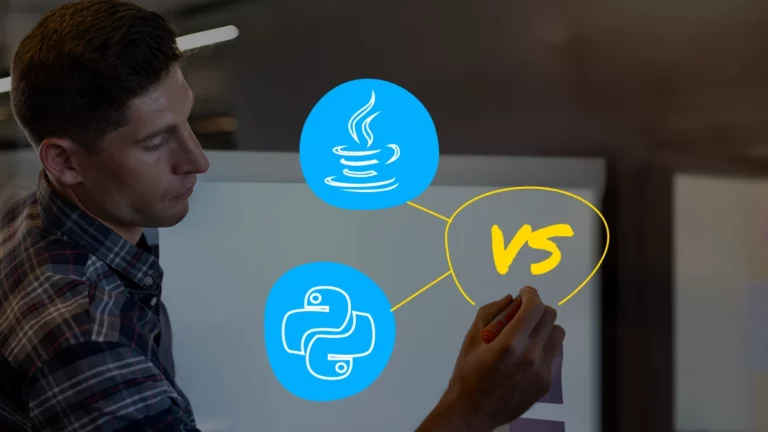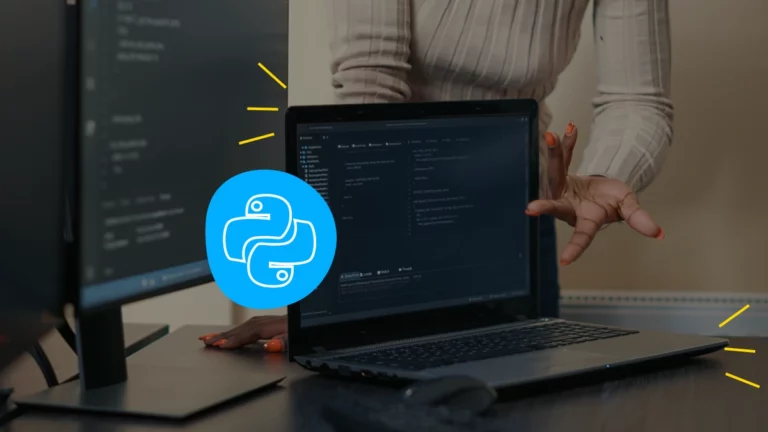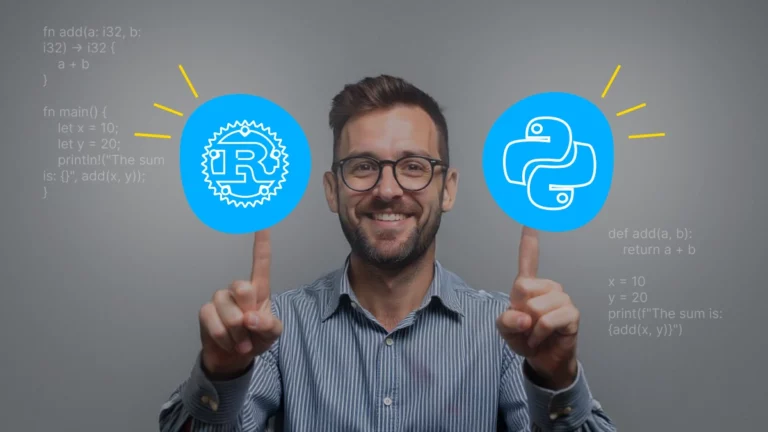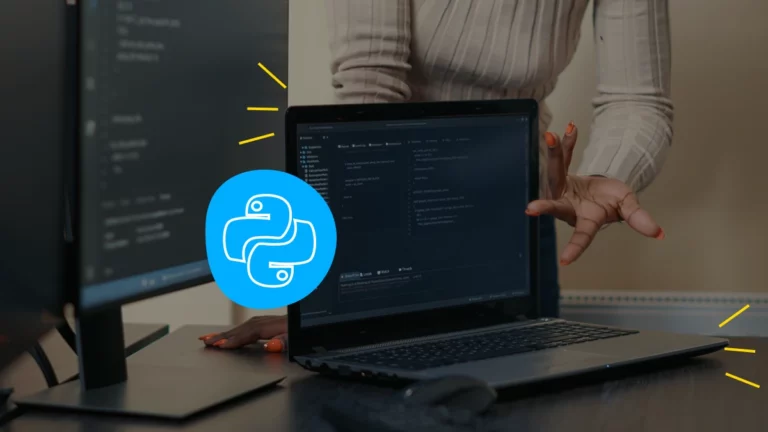Go vs Python: A Comprehensive Guide to Picking the Right Language for Your Project in 2025
- Exploring the Basics of Golang and Python
- Python vs Golang: A Feature-by-Feature Comparison
- Popular Libraries and Frameworks
- Suitability for Large Projects
- Learning Curve
- Error Handling
- Differences Between Go and Python: Performance Benchmarks
- Community Support and Resources for Golang vs Python
- Golang vs Python: Real-World Use Cases
- Salaries of Python vs Go Developers
- Final Words
The right technology is vital for your project’s success and cost-effectiveness, so choosing the wrong programming language can increase its development time and investments.
This guide compares Python and Golang’s key features, toolkits, scalability, and performance. We’ll also look at real-world use cases, developer salaries, and ways to cut costs.
Exploring the Basics of Golang and Python
According to Stack Overflow, 51% of tech professionals and beginners have used Python during the last year, making it the third most popular programming, scripting, and markup language. 13.5% of respondents marked Go, which has gained the thirteenth position.
Python and Go are general-purpose programming languages, meaning coders use them to build software in various domains. They are also open-source programming languages that are accessible, transparent, free for distribution, and widely adopted.
Go is the programming language developed by Google in 2009, and it’s designed for scalability, performance, and simplicity. Python is 18 years older than Go (1991), and it emphasizes rapid development and readability.
Here’s a highlight of the key characteristics of both languages
| Aspects | Golang | Python |
| Popular Frameworks | Gin, Echo, Beego | Django, Flask, FastAPI |
| Community | Growing, pragmatic, system-focused | Large, diverse, beginner-friendly |
| Learning Curve | Steepier | Gentle |
| Memory Management | Automatic, with a focus on efficiency and manual — for specific projects | Automatic, primarily using reference counting |
| Use Cases | -Scalable microservices -High-performance web servers and APIs -Real-time apps -CLI tools and DevOps -Networking and proxy servers -Distributed systems -Data processing pipelines | -Web development -Data Science and Machine Learning -Automation and scripting -Scientific computing and research -Game development -IoT development -Natural Language Processing (NLP) |
| Key Benefits | Minimalism, efficiency, and scalability | Simplicity, readability, and developer productivity |
Python vs Golang: A Feature-by-Feature Comparison
Let’s highlight the strengths of Golang and Python to help you determine which one matches your development needs.
Typing and Compilation
Go is a statically typed language, meaning that engineers define the code variable’s type (not a value) and can’t change it throughout the program.
Go is also a compiled language, which means that before the program executes, at compile time, the source code is transformed into machine-readable object code and checked for syntactical and structural errors. This way, developers make less bugs due to inattentiveness.
Being a procedural language, Go emphasizes using functions to structure the program, executes code instructions sequentially, and focuses on explicit control.
Go’s strict, static typing and compilation model can require more upfront work. Still, it tends to yield faster and more predictable performance at runtime compared to Python.
Python is a dynamically typed language, which implies that a programmer can change the types of variables over their lifetimes. These changes are verified at the final stage: the code running.
Python is an interpreted language that runs code line by line. It allows for rapid development and flexibility, but typing or logic bugs can surface at execution, potentially extending the debugging phase.
Python is an object-oriented language that promotes modular, reusable, and maintainable code ideal for complex software projects.
Takeaway
Python’s dynamic typing and interpreted nature prioritize rapid development and flexibility, suiting projects like data-driven apps, complex modular software, and prototyping. Go’s static typing and compilation ensure type safety and high performance, making it perfect for large, robust apps, like microservices.
Syntax and Readability
Go enforces strict programming rules that promote clarity and consistency by raising compile-time errors for declared but unused variables or imports.
The gofmt command-line tool is typically built in IDEs (Integrated Development Environments), like GoLand and VSCode. It formats the code according to Go’s standard code style as developers type and save the changes.
Go prioritizes readability through minimalism and simplicity.
Python uses mandatory indentation to separate code blocks. Each statement must be written on a new line, avoiding semicolons or braces.
Most Python IDEs and editors like PyCharm integrate the tools that automatically apply formatting on save or provide warnings on style violations.
Python emphasizes readability with its clean coding conventions, allowing for concise, expressive coding.
Takeaway
Due to its clean, indentation-based syntax and emphasis on readability, Python is widely used for rapid prototyping and is preferred by beginners. Go is ideal for scalable, collaborative environments because its explicit, structured syntax facilitates consistency and clarity.
Concurrency Models
Go‘s concurrency model is one of its prominent functionalities, and it’s built around goroutines and channels.
Goroutines are lightweight (~2KB) yet dynamically growing threads that allow engineers to run functions independently without blocking the main program.
Channels are data structures that manage communication between goroutines, eliminating the need for shared memory or explicit locks. Channels enable flexible concurrent patterns, making Golang highly effective for parallelism.
Python supports concurrency through several modules. Its threading module allows several threads to run concurrently while its Global Interpreter Lock (GIL) prevents parallel code execution in a single process.
The asyncio module manages asynchronous tasks using an event loop. It is ideal for I/O (Input/Output) tasks and does not create new processes or threads.
The multiprocessing module achieves true parallelism, bypassing the GIL, and is suitable for CPU-bound tasks. It uses shared memory, process-specific locks, and queues for control.
The concurrent.futures module is built on top of the multiprocessing module, providing a simpler and higher-level API for concurrent tasks that don’t need advanced control.
Takeaway
Go’s built-in lightweight and efficient concurrency with goroutines and channels is ideal for real-time apps, distributed architectures, and microservices. Whereas Python relies on libraries that offer versatility which is better suited for data analysis, machine learning, and automation, despite being limited by GIL.
Performance Considerations
Since Go is a compiled language, it’s faster than Python in terms of runtime performance and has effective concurrency, garbage collection for memory management, and minimal external dependencies. So, Golang is optimized for speed, scalability, and efficiency.
Python prioritizes development speed and ease of use over raw performance. Its line-by-line interpreted nature makes it slower than compiled languages, while dynamic typing adds flexibility but slows down execution.
The GIL limits true multithreading, and for computationally intensive tasks, Python requires an external library, NumPy, that relies on C extensions.
Takeaway
When comparing Go vs Python performance, it’s vital to note that software engineers use Go for high-performing systems due to its compiled nature, efficient concurrency, and low memory overhead. Python code prioritizes flexibility and extensive libraries over speed, making it practical for optimizing specific tasks.
Popular Libraries and Frameworks
Libraries and frameworks are essential toolkits that enhance productivity and simplify coding. They provide pre-written code for common tasks. Let’s compare the most popular tools for the Go and Python languages.
Go vs Python: Top Libraries and Frameworks

Top 3 Go Libraries
These are the top three libraries that simplify and optimize Go development.
1. GORM
This ORM library is rich in features and supports a variety of databases, including MySQL, PostgreSQL, SQL Server, and SQLite. It was designed for data-driven applications, complex data models, and scalable backend systems. GORM comes with customizable and extensible APIs for advanced query building and integration.
2. Gorilla
Gorilla Mux is a powerful HTTP request router and dispatcher for Go. It enables flexible and powerful routing by supporting variables, regular expressions (Regex), and middleware. It’s very popular for writing high-performance APIs, secure web applications, and scalable microservices.
3. Viper
Viper is a multipurpose configuration management library for complex app configurations. It’s catered for multiple formats, environment variables, remote configuration systems, and command-line flags. Engineers use Viper to build dynamically configurable applications, distributed systems, and microservices.
Top 3 Go Frameworks
Below is the list of the top three powerful frameworks designed to streamline development in Golang.
1. Gin
This web framework offers an extensive plugin ecosystem and a low memory footprint. Its HTTP router allows coders to enable fast request handling and add functionality like logging, CORS (Cross-Origin Resource Sharing) extension, and authentication.
2. Echo
Echo features robust routing, intuitive API, and extensive documentation, including template rendering, data binding, and request/response handling. Its lightweight design ensures the high speed and scalability of modern applications.
3. Beego
Following the MVC (Model-View-Controller) Architecture, Beego offers embedded functionalities like session management, ORM, caching, and logging. This modular design framework covers versatile development needs.
Top 3 Python Libraries
Python’s extensive ecosystem includes thousands of libraries. Here are the top three foundational ones widely used for data-focused projects.
1. NumPy
NumPy is a powerful library for numerical computing that performs advanced math operations on multidimensional arrays and matrices. It is widely used in data analysis, scientific computing, and machine learning.
2. Pandas
The Pandas library provides intuitive, high-performing tools for processing organized information. Its DataFrames and Series effortlessly handle tabular and time-series data. Pandas is often used for Data Science projects.
3. Matplotlib
With this versatile library, Python developers can generate charts, histograms, 3D plots, heatmaps, error bars, spectrograms, etc. Matplotlib’s customization functionality makes it ideal for creating clear, high-quality graphs.
Top 3 Python Frameworks
Python has dozens of frameworks aimed at domains like web development, data visualization, ML and AI, game development, and automating and testing. Here are the three most popular Python frameworks:
1. Django
This full-stack web framework is known for its “batteries-included” philosophy, as it boasts many built-in tools. Its ORM (Object-Relational Mapping), authentication, and admin panel help engineers build scalable and secure web applications.
2. Flask
Flask’s minimalism, flexibility, and lightweight design make it perfect for web development. This micro-framework allows programmers to add only necessary components and easily integrate with external tools.
3. FastAPI
Once you have a data-intensive ML project, this high-performance web framework will help you create scalable APIs ready for production. It also supports automatic documentation generation with JSON Schema and OpenAPI.
Suitability for Large Projects
Let’s analyze the features of Python and Golang regarding their adaptability to large-scale projects. We’ll compare the two languages against several parameters.
| Needs/Language | Golang | Python |
| Efficient Resource Utilization and Fast Execution | Has compiled execution and optimized concurrency that allows for building high-performance applications with minimal memory usage and fast response times | Python’s interpreted nature slows down execution, but versatile libraries allow devs to improve performance in data-heavy and AI-driven applications |
| Ability to Grow With Business Needs | With goroutines and efficient memory management, engineers can create highly scalable, concurrent applications best for microservices and distributed systems | Handles data-intensive scaling well, but needs other languages for real-time, high-concurrency workloads |
| Code Reliability and Team Efficiency | Go’s strict typing and enforced code formatting help large development teams write clean, maintainable, and error-resistant code | Readable and modular structure promotes maintainability, but dynamic typing can be challenging in maintaining robustness in large, complex codebases |
| Predictable Time to Market | Explicit typing and fast execution ensure efficient development cycles, minimize delays in launching solutions, and allow to set realistic timelines | Due to Python’s simple syntax and diverse libraries, coders can accelerate development, which is ideal for quick iterations, rapid deployment, and project planning |
| Faster Feature Implementation | Smaller but growing Go’s ecosystem excels in server-side development, networking, and DevOps tools like Kubernetes and Terraform | Boasts an extensive toolkit ecosystem with multiple pre-built solutions for web development, AI, data science, and automation |
Golang excels in performance, scalability, and concurrency, which is beneficial for distributed systems, microservices, and fast applications.
There’s probably no language like Python that offers similar simplicity, numerous libraries, and streamlined development that are great for research-focused, data-intensive, and web apps.
Takeaway
When comparing Go vs Python, it’s necessary to highlight that while being versatile and user-friendly, Python doesn’t beat Go’s efficiency and reliability for large, performance-critical, and team-oriented projects.
Learning Curve
Golang is renowned for its simplicity and is easier to learn compared to some statically-compiled languages like C or Java. Unlike these languages, Go avoids advanced concepts like inheritance and operator overloading, which can often overwhelm beginners.
Experienced software engineers transitioning to Go appreciate its straightforward design and the ease with which they can master its core principles. Go’s robust tools, including testing and a well-documented library, further simplify learning.
Python’s clean and intuitive syntax resembles natural language, allowing learners to find solutions rather than recall code design. Indentation and readability help new programmers understand this language’s concepts quickly.
Seasoned coders appreciate Python’s versatility and seamless integration with other technologies. Its flexibility and simplicity make it a popular option for automating tasks, building apps, conducting data analysis, and other projects.
Takeaway
When deciding on Go or Python, it’s vital to remember that Python is a more straightforward language to learn due to its simple, intuitive syntax and extensive learning resources. However, Golang is best suited for coders seeking scalability and performance in system-level programming.
Error Handling
Golang takes a unique approach to errors. It handles them as regular values and encourages software engineers to treat them explicitly, which results in transparent and predictable error management and monitoring errors through the code.
For instance, many functions in Go automatically generate an error message. Though this makes the code more verbose, developers can immediately check whether the error value equals ‘nil’ or contains a message.
Python uses an intuitive and powerful exception-based error-handling system. Its built-in warning messages appear during code execution and state the error type and the number of the faulty line.
Programmers can use the try-except block to avoid program crashes and catch exceptions. It contains the code that might raise an exception and specifies what to do with it, allowing for graceful error recovery.
Takeaway
When considering whether Golang or Python manages errors more effectively, remember that Go supports strict, explicit error handling that fosters readability and control, which is ideal for robust systems. The exception-based approach behind Python emphasizes simplicity and clarity, making it more appropriate for flexible workflows and rapid development.
Differences Between Go and Python: Performance Benchmarks
Performance metrics enable project managers to assess how a language behaves under specific conditions. These parameters help evaluate whether the language can handle certain tasks, ensure scalability, and serve as a cost-efficient solution.
Should you pick Python for backend development or Go for machine learning? Let’s discover.
Go
Unlike Python, the Go language is designed for high performance, especially in the areas requiring efficiency, scalability, and concurrency.
Its key performance benchmarks are:
- Efficient concurrency. Go’s runtime scheduler allows thousands of goroutines to operate concurrently without explicit locking, streamlining parallel programming.
- Minimal memory. It’s a fact that Go is ideal for resource-constrained, high-performing apps due to optimized goroutine stack sizes and garbage collector.
- Fast compilation and execution. Go is fast due to its machine-code generation and designed-for-speed compiler, which delivers swift execution and low-latency performance.
- High app loading speed. Go’s efficient runtime and minimal initialization processes ensure an almost instant app start, ideal for microservices, CLI tools, and real-time systems.
Python
The Python programming language prioritizes ease of use and engineer’s productivity while keeping the performance secondary.
Its primary efficiency metrics are:
- Optimized performance in data-intensive domains. While Python is slower compared to Go because of its interpreted nature, its vast library ecosystem allows coders to enhance efficiency in areas like scientific computing, ML, and data analysis.
- Flexibility. Dynamic typing and runtime interpretation give Python unmatched flexibility, enabling rapid prototyping and adaptability to evolving project requirements. This feature is especially critical for domains like automation and web development.
- Robust concurrency for I/O-bound tasks. Though Python has limited CPU parallelism, it provides powerful concurrency capabilities through asyncio, threading, and multiprocessing, making it highly effective for input/output operations.
- Rapid prototyping. Python is one of the best languages for turning ideas into working prototypes due to its vast ecosystem of libraries, readable code, and interactive environments.
Community Support and Resources for Golang vs Python
Community support is crucial for the success of a programming language, as it fosters its adoption, growth, and innovation. Let’s compare this aspect in both languages.
Golang
Go has a rapidly growing community known for its strong support and extensive resources.
Go experts organize groups and hold in-person and virtual meetings to connect. Regular conferences, like GopherCon, bring together community members for tasks, workshops, and networking.
The Go website features extensive guides and learning resources. The Go Forum, GitHub repositories, and platforms like Stack Overflow become active spaces for troubleshooting, knowledge sharing, and discussing best practices.
A vast ecosystem of open-source projects provides valuable learning resources and opportunities to contribute to the Go community.
Python
The Python community is renowned for its immense size, vibrant nature, and resource wealth.
Python User Groups (PUGs) offer local meetups and events for learning and networking. Major conferences like PyCon and EuroPython unite members for discussions and networking opportunities.
While the official Python website provides guides and documentation, Stack Overflow and similar platforms create forums for tech adepts to share experiences and learn about trends.
Python boasts a vast ecosystem of open-source libraries and projects that contribute to the popularity of this programming language.
Takeaway
When deciding on Python or Golang, keep in mind that both languages boast vibrant communities but differ in size and focus. The Python language has a vast ecosystem and beginner-friendly resources, while the Go programming language community is known for its strong, focused support and pragmatic approach.
Golang vs Python: Real-World Use Cases
Use cases help business owners estimate development costs, timelines, and the team’s skill set, providing context for choosing between Go and Python.
Go Use Cases
The typical applications of Golang include:
1. Web Servers and APIs
Software engineers use frameworks like Gin, Echo, and Fiber to create scalable RESTful APIs and also simplify building reliable and fast web servers. For instance, Dropbox moved its core system services from Python to Go to improve the platform’s performance and scalability. Uber used Go for its geofencing and matching system to effectively handle high-performance requests. At the same time, Netflix deploys Golang for multiple distributed systems, including the API gateway, which receives millions of daily requests.
2. Microservices and Distributed Systems
Go’s simple binaries and advanced gRPC and Go kit frameworks make building high-performance, scalable distributed architectures easy. Cloudflare, in particular, relies on Golang to implement its distributed networks and load-balancing services. Monzo, a digital bank, built its entire banking infrastructure on Go-based microservices, while the containerization platform Docker was built in Go to manage distributed systems effectively.
3. Real-Time Apps
Chat apps, gaming servers, and live streaming platforms written in Go are reliable because engineers use minimal memory resources and leverage its efficient concurrency during the development process. A case in point is Alibaba, which uses Go to power its real-time transaction processing and fraud detection systems. Golang also powers SendGrid’s real-time email processing and delivery tracking as well as the Dailymotion video-sharing platform’s real-time content recommendations.
4. CLI (Command Line Interface) and DevOps Tools
Go’s simplicity, portability, and performance, as well as libraries like Cobra and urfave/cli help programmers build CLI and DevOps instruments. For instance, Vault, a tool for managing secrets and sensitive data, and Prometheus, a monitoring and alerting toolkit that collects real-time data, are developed in Go. Docker, the leading containerization platform, is also built with Go and includes a powerful CLI.
5. Network Applications
Go’s net and net/http packages provide powerful tools for handling TCP/IP, UDP, and HTTP protocols, making it possible to develop servers, proxies, and VPNs quickly. For instance, Traefik is a modern reverse proxy and load balancer written in Golang that manages microservice traffic. This language is also employed by Syncthing, which is a P2P file synchronization app with secure networking. Some modern VPN solutions, like Tailscale, are also written in Golang to simplify secure private networking.
6. Data Processing Pipelines
Go’s channels, maintained through parallel processing, guarantee safe communication between pipeline stages. Furthermore, libraries include tools for file manipulation, JSON handling, and more. For instance, Apache Pulsar, a real-time messaging and data streaming platform, uses Go’s concurrency model for high-throughput data ingestion and real-time event processing.
Python Applications Across Industries
Python is widely used in the following domains:
1. Data Science and Machine Learning
Python language is the best choice for data analysis, AI, and ML projects thanks to powerful libraries like Pandas, TensorFlow, and Scikit-Learn. Notably, Google uses Python-based TensorFlow for AI-driven search algorithms, image recognition, and deep learning. Netflix’s recommendation engine also leverages Python to personalize content suggestions based on user behavior. Tesla’s self-driving AI is built using Python-based deep learning frameworks for real-time image processing.
2. Web Development
Tech specialists choose Python for its extensive frameworks like Flask and Django to build dynamic and secure web applications. Instagram’s backend, for example, is built using Python’s Django framework, handling millions of daily active users, while YouTube leverages Python to manage content delivery, recommendations, and server-side operations. At the same time, Spotify’s web platform and API services are also powered by Python and enable music streaming and recommendations.
3. Scripting and Automation
Python’s simplicity is an excellent advantage for automating data extraction, system monitoring, file activity, and other routine operations. For example, NASA employs Python to automate data collection, analysis, and visualization for research missions, and X uses this language for bot automation, content scheduling, and trend analysis. Furthermore, Google automates its cloud infrastructure, system monitoring, and server management with Python.
4. Scientific Computing
Other languages can’t replace Python for numeric computations, simulations, and data visualization due to libraries like NumPy, SciPy, and Matplotlib. For example, the Weather Channel relies on Python for its meteorological data and severe weather forecasts. The LIGO (Gravitational Wave Detection) scientists work with Python to analyze signals from black hole and neutron star collisions, just as NASA employs Python to work with space data, simulate planetary movements, and analyze satellite images.
5. Game Development
With the Pygame and Panda3D libraries, engineers can create games and interactive apps through rapid prototyping and seamless integration with C/C++. For instance, Python powers the server infrastructure of player interactions, AI units, and game physics in World of Tanks, and Battlefield 2 utilizes Python for gameplay scripting and modding. Moreover, Python is employed for modding Minecraft and automation tools like Minecraft Pi Edition.
6. IoT and Embedded Systems
MicroPython and CircuitPython frameworks let Python run on low-resource devices, while Socket, MQTT, and Adafruit IO facilitate IoT protocols and communications. Namely, IBM uses Python for predictive maintenance and AI-powered industrial IoT applications, while Python also powers home automation systems like Google Nest and the open-source Home Assistant platform. Philips applies Python for processing data from medical IoT devices like patient monitoring systems.
7. Prototyping for Startups
With toolkits like NumPy, Flask, and Pandas, web development, data analysis, and other tasks have become more efficient, enhancing opportunities for rapid modeling with Python. For instance, Dropbox’s prototype was built in Python, allowing users to store files on the cloud with automatic synchronization seamlessly. Similarly, Spotify initially used Python to build the server side of its streaming and recommendation services. Moreover, Reddit was also built with Python, which made it easy to test new features quickly and manage user content efficiently.
Takeaway
Go’s compiled nature, low memory usage, and efficient concurrency model ensure superior performance for scalable, high-performance applications such as microservices, real-time systems, and network tools.
With its simplicity, extensive libraries, and dynamic typing, Python shines in rapid development, Data Science, ML, and automation.Golang will perform better than Python in high-speed and resource-efficient tasks, and Python’s flexibility and ecosystem make it perfect for prototyping, research, and data-driven applications.
Salaries of Python vs Go Developers
Stack Overflow reports an annual compensation (globally) of $67,559 for Python programmers and $75,362 for Golang developers.
Let’s explore the annual remunerations of Golang vs Python software engineers worldwide (Glassdoor, DOU).
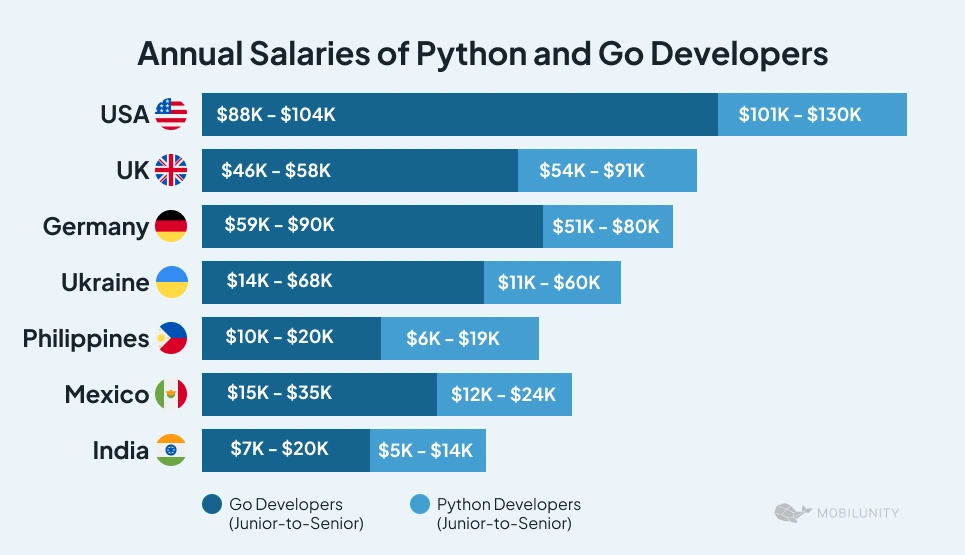
As you can see, for companies based in Western Europe and the US, hiring tech experts in Eastern Europe, LATAM, and Asia is, on average, 40%-60% more cost-effective compared to local employment. However, in terms of price/quality ratio Eastern Europe appears to be the leading destination.
We can confirm the current rates for Ukraine, as EU and US-based businesses from diverse domains regularly contact Mobilunity to hire offshore and nearshore dedicated tech teams.
Here’s what our clients say about cooperation with Mobilunity:
Final Words
The Golang vs Python comparison calls for a thoughtful analysis of your project’s needs. While Go excels in performance-critical systems, Python offers versatility and a vast ecosystem.
Assessing the language’s development speed, performance, and maintainability can help you make an informed decision that aligns with your project’s goals and ensures long-term success. Additionally, you can consider cutting costs by hiring a remote development team.
Disclaimer: All salaries and prices mentioned within the article are approximate numbers based on the research done by our in-house Marketing Research Team. Please use these numbers as a reference for comparison only. Feel free to use the contact form to inquire on the specific cost of the talent according to your vacancy requirements and chosen model of engagement.

